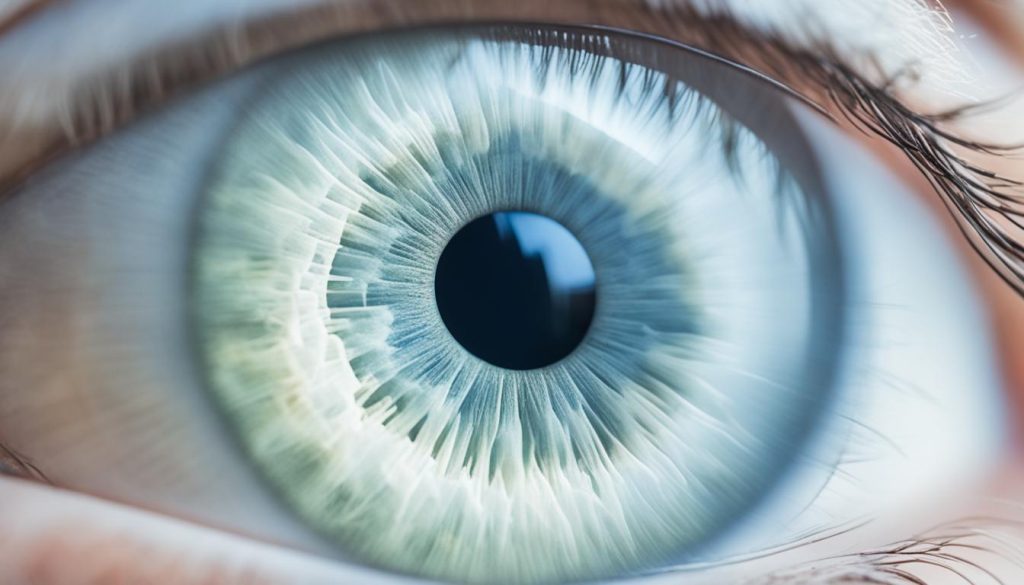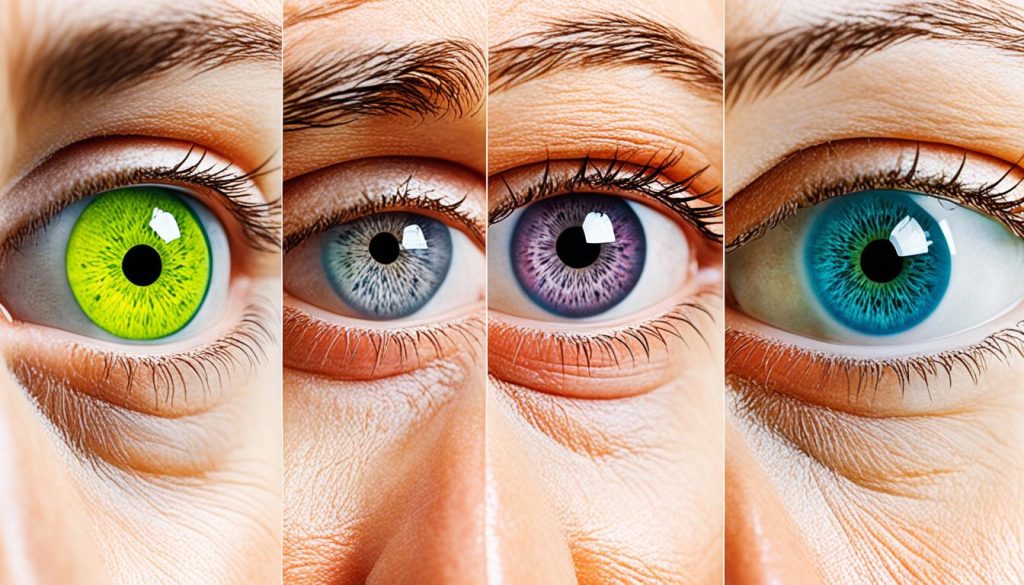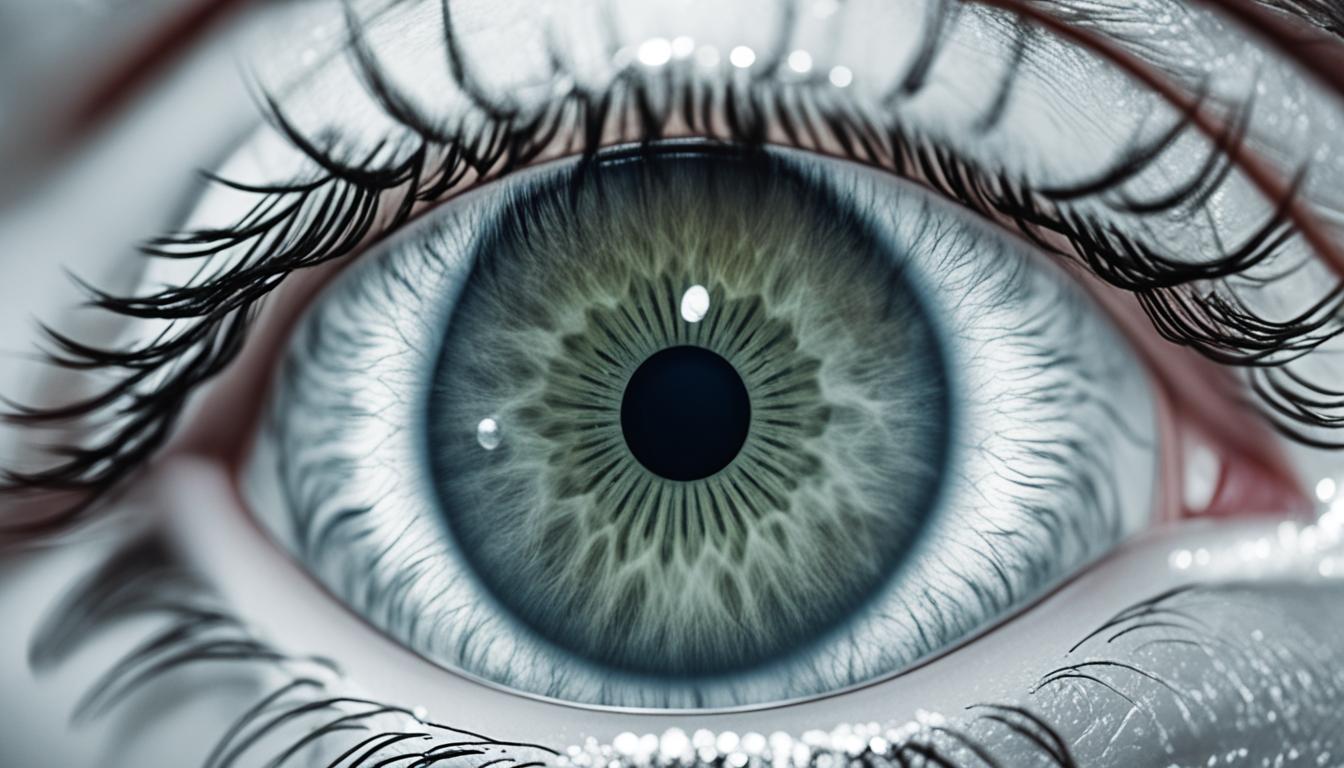Cataracts, a common eye disease, are a leading cause of blindness. Many people wonder, “How long does it take to go blind from cataracts?” The progression of cataracts and the timeline for blindness can vary depending on the type of cataract and individual factors.
Age-related cataracts, the most common type, typically take decades to cause complete vision loss. However, other types of cataracts, such as traumatic cataracts, can lead to more rapid vision loss. It’s important to understand the different types of cataracts and their impact on vision health.
In this article, we will explore the causes, symptoms, types, and treatment options for cataracts. We will also discuss preventative measures and the importance of early detection. So, if you’re curious about cataracts and their impact on vision, continue reading to gain valuable insights into this eye condition.
What are Cataracts?
Cataracts are a common eye disease that affects millions of people worldwide. They occur when the natural lens of the eye becomes cloudy, leading to blurred vision and other visual disturbances. Cataracts can develop in one or both eyes and can occur at any age, although they are more common as we get older. In fact, cataracts are a leading cause of blindness, making it crucial to understand their causes, symptoms, and available treatment options.
The clouding of the lens in cataracts prevents light from properly passing through the eye, which impairs vision. It can cause blurred or hazy vision, difficulty seeing at night, increased sensitivity to light, faded colors, and the appearance of halos around lights. As the cataract progresses, these symptoms may worsen, making it increasingly challenging to perform daily activities.
Cataracts are often associated with aging, hence the term “age-related cataracts.” However, other factors can contribute to their development as well. These include long-term exposure to ultraviolet (UV) radiation from the sun, eye injuries, certain medical conditions like diabetes, smoking, excessive alcohol consumption, and prolonged use of corticosteroids. Genetics may also play a role in some cases.
Types of Cataracts
There are different types of cataracts, each with its own characteristics and causes:
- Age-related cataracts: These are the most common type of cataracts and typically develop as a result of age-related changes in the lens.
- Congenital cataracts: Some individuals are born with cataracts or develop them shortly after birth. These cataracts may be caused by genetic factors or may be associated with other medical conditions.
- Secondary cataracts: These cataracts can develop as a result of other medical conditions, such as diabetes, or certain treatments, such as long-term use of corticosteroids.
- Traumatic cataracts: Eye injuries, such as blunt force trauma or penetrating injuries, can lead to the development of traumatic cataracts.
It is essential to understand the type of cataract one has, as it can impact the rate of vision loss and the appropriate treatment options.
For a visual representation, refer to the table below:
| Cataract Type | Cause |
|---|---|
| Age-related cataracts | Age-related changes in the lens |
| Congenital cataracts | Genetic factors or other medical conditions |
| Secondary cataracts | Other medical conditions or treatments |
| Traumatic cataracts | Eye injuries |

Symptoms of Cataracts
Cataracts can present with various symptoms that can gradually worsen over time. It is important to be aware of these symptoms to seek appropriate medical attention and treatment. The common symptoms of cataracts include:
- Blurred vision: Cataracts can cause a gradual loss of clarity in vision, making objects appear hazy or fuzzy.
- Halos of light around objects: Cataracts can cause individuals to see bright circles or halos around lights, particularly at night.
- Faded colors: Colors may appear dull or less vibrant with cataracts.
- Sensitivity to bright lights: Bright lights, such as sunlight or car headlights, may cause discomfort or glare for individuals with cataracts.
- Poor night vision: Difficulty seeing in low-light conditions, such as at night or in dimly lit rooms, is a common symptom of cataracts.
- Double vision: Cataracts may cause double vision, where individuals see two images overlapping each other instead of one clear image.
If you are experiencing any of these symptoms, it is essential to consult an eye care professional for a comprehensive evaluation and accurate diagnosis.

Please note that the severity and progression of symptoms can vary from person to person. Regular eye examinations can help detect cataracts early on and allow for timely intervention to preserve vision.
| Symptoms of Cataracts | Severity |
|---|---|
| Blurred vision | Mild to severe |
| Halos of light around objects | Mild to severe |
| Faded colors | Mild to moderate |
| Sensitivity to bright lights | Mild to moderate |
| Poor night vision | Mild to severe |
| Double vision | Mild to moderate |
The table above provides an overview of the common symptoms of cataracts and their potential severity. It is important to note that individual experiences may vary, and it is recommended to consult with an eye care professional for a personalized assessment and treatment plan.
Types of Cataracts
Cataracts are a common eye condition characterized by the clouding of the natural lens of the eye. They can occur in different forms, each with its own unique characteristics and causes. Understanding the different types of cataracts can help individuals and healthcare providers determine the appropriate treatment options and prognosis.
1. Age-Related Cataracts
Age-related cataracts are the most common type and typically develop as we age. Over time, proteins in the lens of the eye may clump together, leading to the clouding of vision. They can progress slowly, gradually impacting visual acuity and quality of life. Age-related cataracts may affect one or both eyes, and their progression can vary from person to person.
2. Congenital Cataracts
Congenital cataracts are present at birth or develop shortly after. They can be caused by genetic factors, intrauterine infections, or certain prenatal conditions. Congenital cataracts may affect visual development in infants and children, leading to reduced vision or even blindness if left untreated. Early detection and prompt intervention are crucial to support normal visual development and prevent long-term complications.
3. Secondary Cataracts
Secondary cataracts can develop as a result of other medical conditions or treatments. For example, individuals with diabetes, certain autoimmune diseases, or a history of prolonged steroid use may be at higher risk. Secondary cataracts can also occur following eye surgeries, such as those for glaucoma or retinal detachment. The underlying causes of secondary cataracts may influence the speed of vision loss.
4. Traumatic Cataracts
Traumatic cataracts can occur following an eye injury, such as a direct blow to the eye or penetration of a foreign object. The trauma disrupts the normal structure of the lens, leading to clouding and impaired vision. The severity of vision loss and the rate of progression depend on the extent and nature of the injury. Prompt medical attention is crucial in managing traumatic cataracts and preventing further complications.
Each type of cataract presents its own challenges and considerations. Proper diagnosis, regular eye examinations, and timely intervention can help manage symptoms and maintain visual acuity. It’s essential to consult with an eye care professional for accurate diagnosis and personalized treatment plans.
| Type of Cataract | Characteristic | Causes |
|---|---|---|
| Age-Related Cataracts | Progressive clouding of vision | Natural aging process |
| Congenital Cataracts | Present at birth or early development | Genetic factors, intrauterine infections, prenatal conditions |
| Secondary Cataracts | Related to underlying medical conditions or treatments | Diabetes, autoimmune diseases, prolonged steroid use, eye surgeries |
| Traumatic Cataracts | Develops following an eye injury | Direct blow to the eye, penetration of a foreign object |

Causes of Cataracts
While the natural aging process is the main cause of cataracts, there are several other factors that can contribute to their development. Understanding these causes can help individuals take preventive measures and make informed choices to protect their vision.
1. Age
As we age, the risk of developing cataracts increases. Age-related cataracts are the most common type and typically develop over many years. The lens in the eye gradually becomes less transparent, leading to vision problems over time.
2. Lifestyle Factors
Several lifestyle factors can increase the risk of cataracts. Excessive exposure to UV-B radiation from the sun and tanning beds can accelerate cataract formation. Protecting the eyes with sunglasses that offer UV protection can help mitigate this risk. Smoking and excessive alcohol consumption have also been linked to an increased likelihood of developing cataracts.
3. Medical Conditions
Certain medical conditions play a role in cataract development. Diabetes, in particular, increases the risk, as elevated blood sugar levels can impact the health of the lens. People with diabetes should manage their blood sugar levels carefully to reduce the risk of cataracts. Additionally, the long-term use of steroids can promote cataract growth.
Eye Injuries
Eye injuries, whether from accidents, trauma, or surgery, can contribute to the development of cataracts. Any physical injury to the eye can disrupt the delicate balance of the lens, leading to clouding and vision impairment.
It’s important to note that while these factors can increase the risk of cataracts, they do not guarantee the development of the condition. Conversely, people without these risk factors can still develop cataracts. Regular eye examinations and early detection are key to managing cataracts and preserving vision.

| Causes of Cataracts | Description |
|---|---|
| Age | The natural aging process is the primary cause of cataracts. The risk increases with age, and age-related cataracts usually develop gradually over many years. |
| Lifestyle Factors | Exposure to UV-B radiation, smoking, excessive alcohol consumption, and poor diet can contribute to cataract formation. Protecting the eyes from the sun and adopting a healthy lifestyle can help lower the risk. |
| Medical Conditions | Diabetes and the long-term use of steroids are associated with a higher risk of cataracts. Managing these conditions can help mitigate the risk. |
| Eye Injuries | Physical trauma to the eye, including accidents or surgical procedures, can increase the likelihood of developing cataracts. |
How Long Does It Take to Go Blind From Cataracts?
The progression of cataracts and the time it takes to cause complete blindness can vary depending on the type of cataract and individual factors. Age-related cataracts, which are the most common, typically develop gradually over the course of several decades before leading to blindness. This slow progression allows individuals to adapt to changes in their vision and seek appropriate medical intervention.
In contrast, other types of cataracts, such as traumatic cataracts resulting from eye injuries, can cause more rapid vision loss. These cataracts may lead to worsening visual impairment and potentially blindness in a shorter period of time.
It is important to note that the rate of visual impairment and the time it takes to go blind from cataracts can also be influenced by individual factors such as overall eye health, lifestyle choices, and the presence of underlying medical conditions.
Early detection and timely intervention through cataract surgery can help prevent or delay significant vision loss. Cataract surgery involves removing the cloudy natural lens of the eye and replacing it with an artificial lens. This procedure is safe and effective, allowing individuals to regain clear vision and improve their quality of life. Regular eye exams are crucial for monitoring cataract progression and determining the appropriate timing for surgery.
Awareness of the symptoms of cataracts, such as blurred vision and sensitivity to light, is essential in recognizing the need for medical attention. With early intervention and proper management, individuals can maintain their visual acuity and continue to enjoy optimal eye health and well-being.
Treatment Options for Cataracts
Cataracts can significantly impact your vision and quality of life. Fortunately, there are effective treatment options available, with cataract surgery being the most common and successful approach. Cataract surgery involves the removal of the cloudy natural lens and its replacement with a clear artificial lens. This procedure aims to restore clear and sharp vision, enabling individuals with cataracts to regain their visual clarity and functionality.
During cataract surgery, the surgeon will make a small incision in the eye, through which the cloudy lens is carefully removed. Once the lens is taken out, an intraocular lens (IOL) is inserted to replace it. The IOL is made of a biocompatible material and is designed to improve visual acuity. This lens is positioned in the same location as the natural lens, ensuring optimal vision correction.
Cataract surgery is generally a safe and effective procedure, with a high success rate in improving vision. It is performed on an outpatient basis, meaning most patients can return home on the same day of the surgery. The recovery period is relatively short, and patients can typically resume their normal activities within a few days.
It’s important to note that cataract surgery is not always required in the early stages of cataract development. In some cases, glasses or contact lenses may be sufficient to correct vision and manage symptoms. However, as cataracts progress and significantly impact daily life activities, surgery becomes the recommended treatment option.
It is crucial to consult with an ophthalmologist to determine the most appropriate treatment approach for your cataracts. They will evaluate the severity of your cataracts, assess your visual needs, and discuss the potential benefits and risks of cataract surgery. Together, you can make an informed decision about the best course of action to improve your vision and overall quality of life.
Prevention of Cataracts
While it is not possible to completely prevent cataracts, there are steps individuals can take to protect their vision and lower their risk of developing cataracts.
- Wear sunglasses or hats: Protect your eyes from harmful UV radiation by wearing sunglasses that block 100% of UV rays or wide-brimmed hats when spending time outdoors.
- Avoid smoking and excessive alcohol consumption: Smoking and excessive alcohol consumption have been linked to an increased risk of developing cataracts. Quitting smoking and limiting alcohol intake can help protect your vision.
- Maintain a healthy diet rich in fruits and vegetables: Eating a diet high in antioxidants, such as fruits and vegetables, can support eye health and reduce the risk of cataracts. Include foods like spinach, kale, oranges, and berries in your meals.
- Manage underlying medical conditions: Conditions like diabetes and high blood pressure can increase the risk of cataracts. Take steps to manage these conditions through medication, lifestyle changes, and regular check-ups with your healthcare provider.
- Regular eye exams: Schedule regular eye exams to detect and monitor cataracts early on. Your eye doctor can determine the progression of cataracts and recommend appropriate interventions.
By incorporating these lifestyle factors into your routine, you can protect your vision and reduce the likelihood of developing cataracts. Remember to consult with your healthcare provider for personalized advice and guidance.
Conclusion
Cataracts are a common and progressive eye condition that, if left untreated, can lead to vision loss. While age-related cataracts typically take decades to cause complete blindness, other types of cataracts can result in more rapid vision impairment. However, there is hope for those affected by cataracts.
The most effective treatment option for cataracts is cataract surgery, which involves the removal of the cloudy natural lens and its replacement with a clear artificial lens. This surgical procedure has proven to be safe and successful in restoring clear vision for individuals with cataracts. Early detection and timely intervention are crucial in preventing significant vision impairment.
Protecting your vision and taking proactive measures can also help reduce the risk of developing cataracts. These include wearing sunglasses or a hat to shield your eyes from harmful UV radiation, avoiding smoking and excessive alcohol consumption, adopting a healthy diet rich in fruits and vegetables, and managing underlying medical conditions. Regular eye exams ensure that any signs of cataracts are detected early, allowing for appropriate monitoring and intervention.
In conclusion, while cataracts can cause vision loss, their progression can be managed with effective treatment options. By staying proactive in protecting your vision and seeking timely medical intervention, you can lower the risk of developing cataracts and maintain clear vision.




